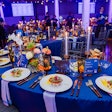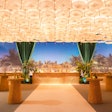
It's never too early to start thinking ahead, especially in a period of so much uncertainty. To get a clearer picture of what the future holds, BizBash is planning a series of articles where top professionals from all aspects of the event industry share their predictions and insights for the year ahead.
Last month, we caught up with lighting and audiovisual producers. Now, we're chatting with floral and event designers. Here's an in-depth look at what five experts around the country are expecting to see in 2022.
1. Floral and labor shortages will force designers to think outside the box.
“AV companies, rental companies, and floral and fabric companies are all impacted due to supply chains and labor issues,” notes David Merrell, CEO and creative director of AOO Events in Los Angeles. “I think we are going to see rental inventories, the varieties available and service level dwindle for a while until the industry can fully rebound.”
Tempering client expectations will continue to be important into 2022—but, he adds, these types of limitations can lead to new levels of innovation. “The saying goes, ‘necessity breeds invention’—so there will be some new cleverness that evolves from this,” Merrell says. “The real question is, how much do we want to push the envelope on new ideas when it is tougher to execute right now? New moods and attitudes when it comes to aesthetic design will start to reveal themselves as things open up.”
Brian Worley, creative director and owner of B. Worley Productions in Atlanta, agrees. “I think that we will also have to get more creative with centerpieces and decor,” he notes. “When florals are just not as easy to come by and the prices are going up, the [traditional] huge centerpieces are going to cost significantly more.”
André Wells, founder and CEO of Events by André Wells in Washington, D.C., hopes that despite the challenges, designers in 2022 will be able to work at the levels they're used to. “This is a very ingenious and creative industry, as seen over the last year and a half,” he says. “We know how to pivot and create environments and solutions that help people gather and get their messages out in a safe, creative and fun manner through events and/or event-related activities.”
Related: 7 Ways Event Planners Can Navigate the Current Flower Shortage
2. In terms of design trends, bold colors are in.
Merrell notes that social events have been and will continue to be the first events to return in person. “On the social side, you are seeing a lot of color in everything—flowers in everything, softness, fullness—all a result of the desire to openly celebrate,” he observes. “We all could use a little color in our lives these days!”
Worley is also predicting bold colors. “I think that in 2022 we will see more bright and bold colors in decor, and especially flowers,” he says. “There is this widespread rumor about how it is really difficult to get white flowers and especially roses, as the growers are working to replenish the stock from the pandemic. I think this gives us the opportunity to stray away from the traditional white wedding and add pops of color, whimsy and fun.”
It’s a trend he welcomes, noting that events, particularly weddings, can often rely too much on traditional white colors. “I also think that lends itself to the Bridgerton theme that could be a popular trend for next year,” Worley adds.
3. But don’t underestimate the power of clean, tranquil spaces.
On the other hand, Kristin Banta, CEO of Kristin Banta Events in Los Angeles, predicts that tranquility will be a big design trend in 2022. “We will see more in the way of spatial design that speaks to tranquility, wellness and peace,” she says. “Comfortable, warm, uncluttered spaces will become the new direction for a post-pandemic era, with an audience now acutely wellness-forward and embracive of mindfulness.”
Merrell is observing a similar trend. “A design trend with many corporate clients of ours is that they are having more intimate events in person,” he says. “The menus and the themes are centered on mindful themes, health and wellness.”  "Comfortable, warm, uncluttered spaces will become the new direction for a post-pandemic era," predicts event designer Kristin Banta.Photo: Katie Edwards Photo
"Comfortable, warm, uncluttered spaces will become the new direction for a post-pandemic era," predicts event designer Kristin Banta.Photo: Katie Edwards Photo
4. Clients will find comfort in nostalgia.
Banta also predicts a shift toward nostalgia. “Nostalgia will drive entertainment and design, in response to a pandemic-era audience living in an unrecognizable world and seeking something familiar,” she predicts.
Worley also sees nostalgia driving design decisions in the social sphere. “I think that anything with a nostalgia flair will be a popular style, and that can mean something to so many people,” he says. “I always say there are no longer traditions in [weddings and social events].”
5. Smaller events are allowing for big design statements and new priorities.
As COVID-19 remains a concern, our experts predict that smaller events will continue being popular. “Micro events will remain a favored approach, offering curated, intimate experiences to small pod-style audiences,” predicts Banta.
“I feel like events have become a lot more casual—more conversational and less formal in style,” adds Wells. “One of my favorites is the contactless check-in and the elimination of traditional check-in stations with long lines. Instead, we now get to make big design statements and have glorious welcoming moments that promote branding and experiential experiences.”
Todd Fiscus, owner of Todd Events in Dallas, is observing more traditional, small, seated dinners, particularly in the social event space. “My favorites are still traditional with just a splash of modern elements,” he says. As for trends to leave in the rear-view mirror in 2022, according to Fiscus? “Wedding neon, too much decor and mirrored aisle runners!"
6. Timelines will change.
Worley predicts that floral and labor shortages will continue into 2022. “I am really pushing my clients to approve everything much further in advance to secure what they want and desire for their [event] day,” he says. “I think it is also very important to emphasize that COVID has really impacted our industry, and our clients need to have some flexibility and understand that we are all in this together and doing our best.”
7. Guest safety will continue to inform design decisions.
“I think as events rev back up, we will continue to see trends which reflect the comfort level of guests at events,” predicts Wells. “Comfort levels are achieved by spacing, design elements and locations—this is done by creating seating pods, soft seating and creative dividers with plant-life, drape and plexiglass elements."
Wells also predicts a continuation of more intimate and personalized decor at events, plus “locations [that are] created and chosen that combine elements of indoor and outdoor atmospheres.” Worley agrees, noting that while guest counts are likely to go back up in 2022, outdoor event options will continue being popular.
On the corporate event side, Merrell notes that it’s harder to predict design trends because corporate clients have been more hesitant to gather in person, as compared to social clients. “Their main concerns are about keeping guests safe and not having their events attached to super-spreaders right now,” he says. “Tastes and new trends come from not wanting to repeat what has already occurred and improve upon them. They are an evolution to the next step considering the consumer’s new moods and attitudes—and all consumers, both social and corporate, have been on lock down.”  "AllSeated’s exVo platform has been a game-changer for me," says Banta. "At the cutting edge of immersive VR experience, it is a groundbreaking tool for virtual and hybrid events."Photo: Courtesy of AllSeated
"AllSeated’s exVo platform has been a game-changer for me," says Banta. "At the cutting edge of immersive VR experience, it is a groundbreaking tool for virtual and hybrid events."Photo: Courtesy of AllSeated
8. Every facet of the industry should be thinking about technology integration.
“Beyond the aesthetic considerations of trends, it is clear that corporations are going to pay more attention to tech integration into events for even more ROI,” continues Merrell, citing tech advancements like RFID technology, 5G capabilities, and advanced virtual and hybrid options that can curate personalized experiences, networking and education opportunities; he’s a particular fan of platforms like AllSeated’s exVo (something Banta also cites as one of her go-to tech products right now).
“It is a great opportunity for our industry, as we now can be in the middle of all those conversations,” Merrell continues. “We now should not only have the ‘live’ event tricks up our sleeves, design-wise, but also tech tricks! It is important that we leverage this new demand to cement our expertise and importance into the marketing and events departments of corporations. We deserve to sit at the creative tables as experts.”
Banta agrees and thinks artificial intelligence will enter more design discussions. “Highly personalized content will drive activation design, and engaging nonprofits to illustrate what a brand stands for will take priority within event marketing strategy and delivery of concept,” she says.
9. Designers shouldn’t be neglecting virtual.
Along the same lines, Banta thinks virtual components are here to stay. “Virtual events will become not just an interim solution for a pandemic-focused world, but an integral part of live events, incorporating AR and VR components as a means of augmenting the in-person experience and creating an immersive experience for the at-home user.”
She continues, “Once annual events are now considering year-round event cycles, as the virtual platform has made this possible from a cost standpoint. The additional offering of a community-based feature will provide the opportunity for year-round content and community.”
10. Designers should lean into their specialties—and don’t try to do it all.
Fiscus sees the design industry thriving in 2022 as in-person events return—but cautions planners and designers to be intentional about finding a work and home balance. “2022 is going to be a push. Don’t get greedy. Find your sweet spot and do enough—but not everything,” he advises.
As for overall wishes for the design industry in 2022? “I hope that we can all continue to take risks in event design,” says Banta, “sparking a sense of whimsy, reimagining our own creativity and putting soul back into the spectacle while delivering content with a conscience.”



















